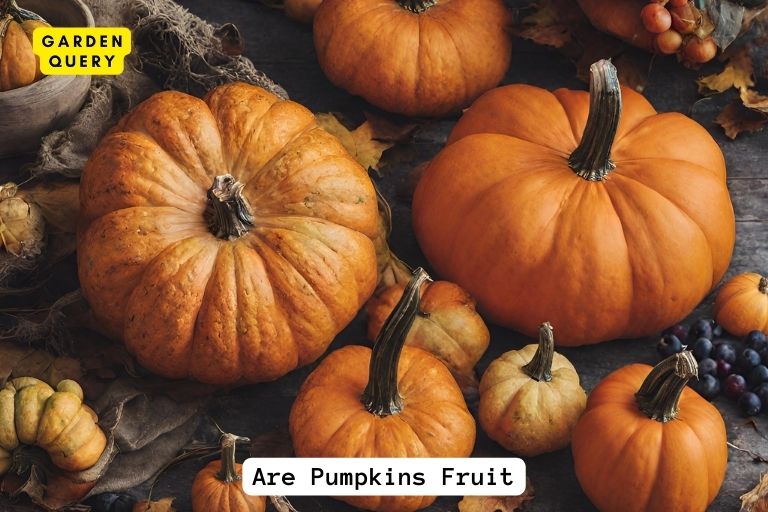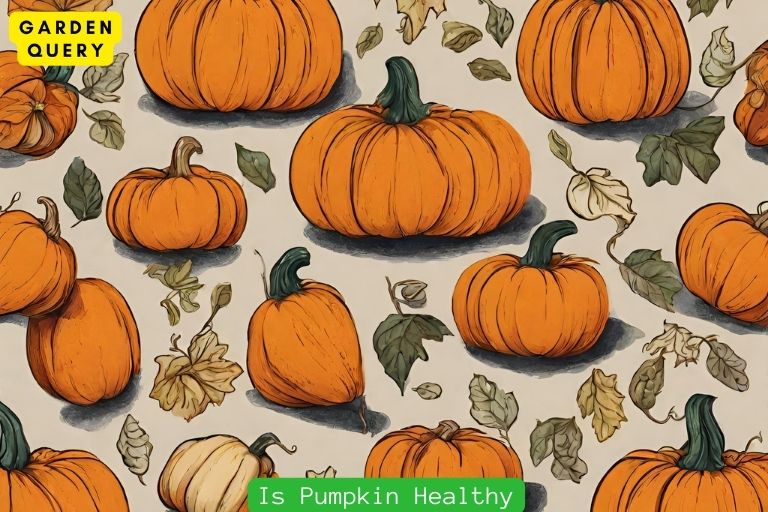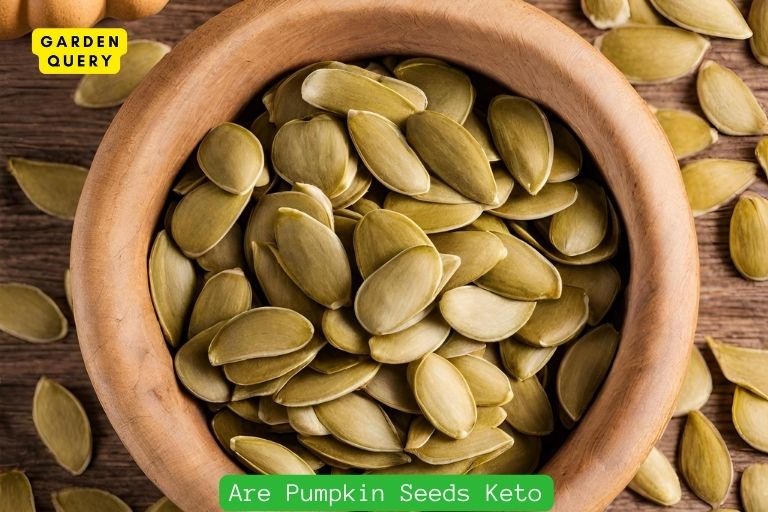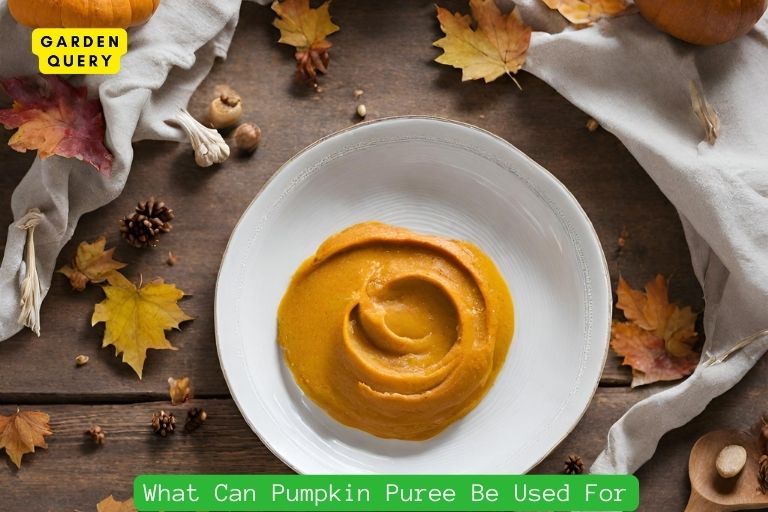How Are Pumpkins Made?
Pumpkins develop through the process of pollination, wherein the female flowers are fertilized, leading to the growth of fruits.
The process of pumpkin formation begins with pollination, usually facilitated by bees transferring pollen from male flowers to female flowers. Once pollination occurs, the female flowers receive the pollen, leading to fertilization. As a result, the ovary of the female flower starts developing into a pumpkin fruit.
Throughout the growth process, the fruit enlarges, while the seeds within it mature. Factors like adequate sunlight, water, and suitable temperatures contribute to the successful formation of pumpkins, which are ready for harvest once fully grown.
Key Takeaway
Pumpkins Made
What Are Pumpkins and their popularity
Pumpkins are widely recognized as round, orange fruits that are most commonly associated with the fall season. They are members of the gourd family and are native to North America. Pumpkins have gained popularity due to their vibrant color, versatility, and association with seasonal festivities such as Halloween and Thanksgiving.
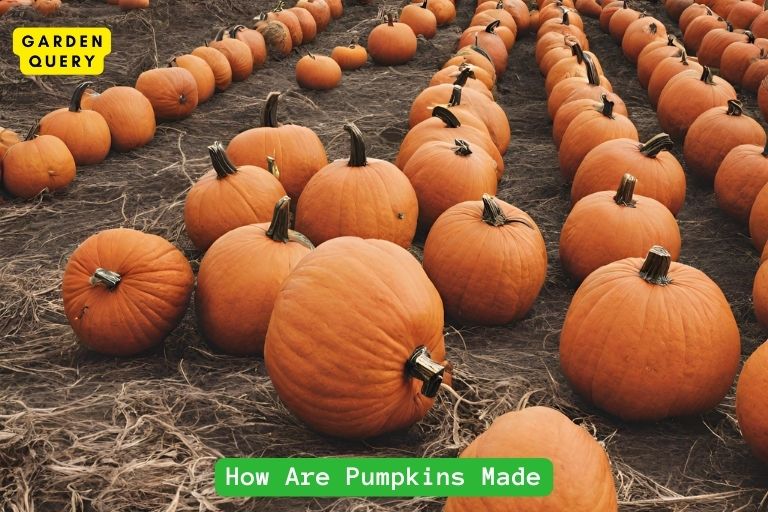
These fruits are known for their distinctive appearance, with smooth or ribbed skin and a thick, hollow interior. They are typically characterized by a hard rind and a fleshy pulp that contains numerous seeds. The flesh of the pumpkin is highly nutritious and is often used in a variety of culinary dishes and desserts.
Pumpkins have also become a symbol of autumn and are widely used for decorative purposes. From front porch displays to intricate carvings for Jack o’ Lanterns, pumpkins add a festive touch to celebrations and create a warm and inviting atmosphere.
The Origin and History of Pumpkins
The cultivation of pumpkins dates back thousands of years. The earliest evidence of pumpkin domestication can be traced back to Central America and Mexico around 7,500 to 5,000 BC. Native American tribes such as the Algonquin, Iroquois, and Cherokee grew and harvested pumpkins as a staple food crop.
The word “pumpkin” originated from the Greek word “pepon,” meaning “large melon.” When European settlers arrived in North America, they encountered pumpkins and quickly adopted them into their diets. Pumpkins played a significant role in early American cuisine and were essential for survival during long winters.
Over time, pumpkins became deeply ingrained in American culture and traditions. They were incorporated into various recipes, such as pumpkin pie, pumpkin bread, and pumpkin soup. The association between pumpkins and Halloween emerged during the 19th century when Irish immigrants brought the tradition of carving turnips and potatoes into Jack o’ Lanterns. Due to the abundance and larger size of pumpkins, they became the preferred choice for carving.
In modern times, the cultivation of pumpkins has expanded globally. They are now grown in various regions across the world, including Asia, Europe, and Australia. With different varieties available, pumpkins are not only limited to the traditional orange color but also come in various hues, shapes, and sizes.
In conclusion, pumpkins have captivated people’s attention for centuries with their vibrant color, versatility, and cultural significance. From their early use as a staple food crop to their current role in decorative displays and culinary creations, pumpkins continue to be cherished and enjoyed by people worldwide.
Growing Pumpkins
Have you ever wondered how pumpkins are made? Well, you’re in luck! Let’s take a closer look at the fascinating process of growing pumpkins from seeds to harvest.
Pumpkin Seeds and Planting Process
It all begins with the humble pumpkin seed. Farmers carefully select high-quality seeds to ensure a successful crop. These seeds are typically planted in late spring or early summer, when the soil temperature has warmed up, and the risk of frost has passed.
First, the soil is prepared by removing any weeds and loosening it to promote good drainage. The seeds are then planted about an inch deep into the soil and spaced a few feet apart to allow room for the pumpkin vines to spread.
Once planted, the seeds require consistent watering and sunlight to germinate. Over the course of a week or two, the seeds will sprout, and tiny pumpkin plants will emerge from the ground.
Caring for Pumpkin Plants
As the pumpkin plants continue to grow, they need proper care and attention to ensure a healthy harvest. Here are some essential steps in caring for pumpkin plants:
- Watering: Pumpkin plants require regular watering to keep the soil moist but not waterlogged. It’s important to water at the base of the plant, avoiding wetting the leaves, as this can lead to disease.
- Fertilizing: Applying a balanced fertilizer specifically formulated for vegetable gardens can provide the necessary nutrients for healthy pumpkin growth. Follow the instructions on the fertilizer packaging for optimal results.
- Weeding: Regular weeding is essential to prevent competition for nutrients and space. Be careful not to disturb the roots of the pumpkin plants while removing weeds.
- Pest Control: Protecting pumpkin plants from pests is crucial. Common pests include squash bugs, vine borers, and powdery mildew. Consider using organic pest control methods or consult with a local agricultural expert for advice.
- Support: As the pumpkin vines grow, they can become heavy with ripe pumpkins. Providing support, such as trellises or straw, can help prevent the pumpkins from rotting on the ground and make harvesting easier.
After a few months of diligent care, the pumpkins will reach their full size and vibrant orange color. It’s now time for the exciting harvest!
Growing pumpkins is a labor of love, requiring patience, dedication, and proper care. From planting the seeds to nurturing the plants, each step plays a crucial role in producing healthy and beautiful pumpkins. So, the next time you pass a pumpkin patch, take a moment to appreciate the hard work and skill that goes into growing these autumn icons.
Development Stages of Pumpkins
Pumpkin Blossoms and Pollination Process
Pumpkins are a beloved symbol of the fall season, often associated with Halloween and Thanksgiving. But have you ever wondered how these vibrant and plump fruits are made? The process starts with pumpkin blossoms and the crucial step of pollination.
Pumpkin blossoms are beautiful yellow flowers that grow on the pumpkin plant. They typically produce both male and female flowers. The male flowers, which appear first, have a long, slender stem and are responsible for producing pollen. The female flowers, on the other hand, have a small embryonic pumpkin at their base, which will form the fruit if successfully pollinated.
Pollination is the transfer of pollen from the male flowers to the female flowers, either by bees, insects, or even the wind. Bees play a vital role in pumpkin pollination as they are attracted to the bright yellow flowers and help carry the pollen from one flower to another.
Once the pollen reaches the stigma of the female flower, it travels down the flower’s style and reaches the ovary. The pollen then fertilizes the ovules, resulting in the development of the pumpkin fruit.
Pumpkin Fruit Formation and Maturation
After successful pollination, the pumpkin fruit begins to develop and mature. The embryonic pumpkin at the base of the female flower grows rapidly, absorbing nutrients from the plant to expand in size.
As the pumpkin fruit develops, it undergoes various changes. The outer skin of the fruit starts to harden and turn into the familiar orange color we associate with pumpkins. The internal flesh also transforms, becoming more fibrous and developing the classic pumpkin flavor and texture.
During this growth stage, it’s essential to provide the pumpkin plant with adequate water, sunlight, and nutrients. Pumpkins require a long period of warm weather, typically 75 to 100 days, to fully mature.
As the pumpkin approaches maturity, the vines and leaves of the plant may start to wither, indicating that the fruit is ready to be harvested. It’s important to harvest pumpkins before frost sets in, as this can damage the fruit.
Once harvested, pumpkins can be used for a variety of purposes, from carving into jack-o’-lanterns to delicious recipes like pumpkin pie and roasted pumpkin seeds. The versatility of pumpkins makes them a staple in fall festivities and culinary delights.
In conclusion, the process of how pumpkins are made involves the blossoming of flowers, pollination, and the development of the fruit. Understanding these stages helps us appreciate the efforts that go into producing this seasonal favorite. So the next time you carve a pumpkin or enjoy a pumpkin-flavored treat, remember the journey it took to reach your plate or doorstep.
Harvesting and Preservation
As autumn arrives and Halloween approaches, you may find yourself surrounded by vibrant orange pumpkins. But have you ever wondered how these seasonal favorites are made? Let’s discover the journey of pumpkins from harvest to preservation.
When to Harvest Pumpkins
Knowing the right time to harvest pumpkins is crucial to ensure their freshness and longevity. Here are a few indicators that help determine when to pick them:
- Color Change: As pumpkins mature, their skin develops a vibrant, deep color, typically orange, depending on the variety. This change in color is a good sign that they are ready for harvest.
- Hardened Skin: The skin of a ripe pumpkin becomes tough and difficult to penetrate with a fingernail. Gently press your nail against the pumpkin’s skin, and if it doesn’t leave an indentation, it’s likely ready to be harvested.
- Drying Stem: Check the stem where it attaches to the pumpkin. If it’s dry and tough, it indicates that the pumpkin is fully mature. Avoid harvesting if the stem is green or soft, as the pumpkin may not be fully developed.
- Timing: Harvest pumpkins before the first frost. Freezing temperatures can damage the pumpkin and reduce its shelf life.
Methods of Storing and Preserving Pumpkins
Once you’ve harvested your pumpkins, it’s vital to store and preserve them properly to maintain their freshness. Here are a few methods to consider:
- Store in a Cool, Dry Place: Find a dark, well-ventilated area with a cool temperature for storing your pumpkins. Avoid damp areas or direct exposure to sunlight, as these conditions can cause rotting or premature ripening.
- Avoid Stacking: To prevent any unwanted pressure or damage, avoid stacking pumpkins on top of each other. Let them have enough space around to ensure proper air circulation.
- Handle with Care: Handle pumpkins gently to avoid any bruises or cuts, as these can contribute to faster spoilage.
- Preserve with Wax: For longer preservation, consider applying a thin layer of vegetable wax or petroleum jelly to the outer skin of the pumpkin. This helps lock in moisture and slow down the rate of evaporation.
- Freezing: If you want to store pumpkin pulp for future uses like pies, soups, or smoothies, consider freezing it. Puree the flesh and store it in airtight containers or freezer bags. Remember to label them with the date and use within a year for the best quality.
By following these harvesting and preservation methods, you can enjoy your pumpkins for an extended period. Whether you’re carving them into spooky jack-o’-lanterns or using them in delicious recipes, the journey of pumpkins from the field to your home is a fascinating process.
Conclusion
In conclusion, pumpkins are harvested when their skin becomes deeply colored, their stem is dried, and they are fully mature. Storing them in a cool, dry place, avoiding stacking, handling them with care, and considering preservation techniques like waxing or freezing can help maintain their freshness and increase their shelf life. So, next time you see a pumpkin, you’ll have a deeper understanding of how it has made its way to you.
Pumpkin Products and Recipes
Popular Pumpkin-Based Products
From pumpkin spice lattes to delicious pumpkin pies, pumpkins have become a staple ingredient in many popular products. But have you ever wondered how these pumpkin-based products are made?
One of the most common pumpkin-based products is pumpkin puree. This versatile ingredient is used in a variety of recipes, including soups, pies, and even pancakes. To make pumpkin puree, pumpkins are first harvested when they are fully ripe. The pumpkins are then washed and cut into halves. The seeds and pulp are removed, and the pumpkin halves are baked until they are soft. Once cooled, the flesh is scooped out and mashed into a smooth puree. This puree can be stored in the freezer for future use or used immediately in various dishes.
Another popular pumpkin-based product is pumpkin oil. Pumpkin seeds are rich in oils and are used to extract pumpkin oil. The seeds are typically roasted before being pressed to extract the oil. Pumpkin oil has a rich, nutty flavor and is often used as a finishing oil for salads or drizzled over roasted vegetables. It can also be used in baking to add a unique twist to bread or muffins.
Delicious Recipes with Pumpkins
Pumpkins are not only used in popular products but also in a variety of delicious recipes. Here are a few mouthwatering recipes that you can try:
- Pumpkin Soup: A classic fall recipe, pumpkin soup is comforting and full of flavor. Simply sauté some onions and garlic, add pumpkin puree, vegetable broth, and your choice of spices. Simmer until all the flavors meld together, then blend until smooth. Finish it off with a garnish of roasted pumpkin seeds or a drizzle of pumpkin oil.
- Pumpkin Risotto: Creamy and savory, pumpkin risotto is a delightful dish to enjoy. Cook Arborio rice with onions, garlic, and vegetable broth. As the rice cooks, gradually add pumpkin puree, parmesan cheese, and your choice of herbs. Stir until the risotto reaches a creamy consistency, then serve with a sprinkle of fresh herbs on top.
- Pumpkin Bread: A delightful treat for breakfast or dessert, pumpkin bread is moist and flavorful. Mix together pumpkin puree, flour, sugar, eggs, and spices like cinnamon and nutmeg. Pour the batter into a greased loaf pan and bake until a toothpick inserted into the center comes out clean. Enjoy it warm with a spread of cream cheese or butter.
These are just a few examples of the many delicious recipes you can create with pumpkins. Whether you’re a fan of sweet or savory dishes, pumpkins offer endless possibilities in the kitchen.
So the next time you enjoy a pumpkin spice latte or a slice of pumpkin pie, you’ll have a better understanding of how those products are made. And if you’re feeling inspired, don’t hesitate to experiment with pumpkins in your own culinary creations!
- Best Therapists In Dallas - February 1, 2024
- Holly Willoughby Husband: Holly Willoughby’s Love Story - January 30, 2024
- Holly Willoughby Dress: 5 Style Secrets and 7 Must-Know Career Milestones - January 30, 2024
